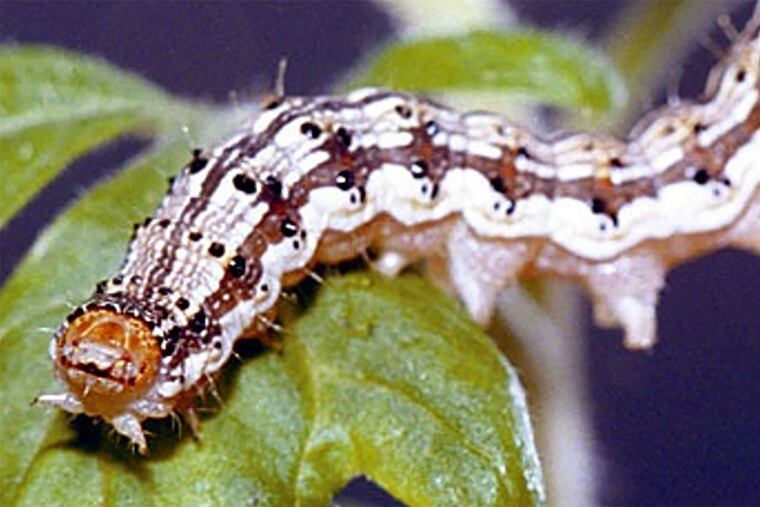‘Like a horror movie’: Caterpillar silences tomato’s cry for help, Penn State scientists find
A caterpillar called the tomato fruitworm not only chomps on tomatoes, but also deposits enzyme-laden saliva on the plant, interfering with its ability to send out a distress signal.

While there’s a famous horror-movie spoof about killer tomatoes, no one seems to have made one about caterpillars — the insect pests that eat the juicy red fruits of summer.
Perhaps the time is ripe, with inspiration from a new study at Pennsylvania State University.
Scientists found that a caterpillar called the tomato fruitworm not only chomps on tomatoes and their leaves, but also deposits enzyme-laden saliva on the plant, interfering with its ability to cry for help.
If it all sounds a bit improbable, starting with the concept of plants crying for help, scientists also scoffed at that idea when it was first proposed a few decades ago. But it has been shown time and again that when under attack, plants can emit chemical distress signals, causing their peers to mount some sort of defense. A classic example is the smell of a new-mown lawn, which prompts the release of protective compounds in nearby blades of grass that have yet to be cut.
In some cases, plant distress signals can even summon help from other species. That’s what happens with the tomato. When caterpillars nibble on the plant’s leaves, the leaf pores release volatile chemicals that are detected by a type of parasite: a wasp that lays eggs inside caterpillars. (Not to overwork the horror-movie analogy, but as with the hapless astronauts in the Aliens franchise, it doesn’t end well for the caterpillar.)
So the Penn State researchers wondered: Could the caterpillars strike back? In a series of experiments, they found that the answer was yes, illustrating a previously unknown strategy in nature’s age-old contest between predator and prey.
The key is the enzyme in the caterpillar’s saliva, which inhibits the opening of pores in tomato-plant leaves, said Po-An Lin, the study’s lead author. That means the leaves are less able to release the distress signals, and presumably less able to attract wasps that could come to the rescue, he said.
The researchers did not use actual wasps in the study, as the insects’ ability to detect these signals is well-established. But the team measured the diameter of the leaf pores and the levels of distress signals that were emitted after being exposed to caterpillar saliva.
The scientists did so both for caterpillars whose saliva contained the enzyme and for those that did not, as a result of having their genes “edited” using the popular laboratory technique called CRISPR. Sure enough, the enzyme-deficient saliva failed to silence the plant’s distress call.
That made for a convincing case, said Chris Martine, a Bucknell University plant geneticist who was not involved in the study.
“This is incredibly cool,” he said. “I’m definitely going to teach this.”
It is not yet clear how the findings could be used in agriculture, but there is no question that help in deterring the caterpillars would be welcomed by those who grow tomatoes and other crops. This species of caterpillar also feeds on corn, cotton, soybeans, strawberries, and cannabis, and is well-established in North and South America, said Penn State entomology professor Gary W. Felton, the study’s senior author.
“It’s a very successful caterpillar,” he said.
Depending on the crop in question, farmers give it different nicknames, such as the corn earworm or the cotton bollworm. One preventive strategy might be to breed plants that are less susceptible to the enzyme’s effects, he said.
Felton has been researching the insect’s salivary enzyme for more than 20 years. In previous studies, he and colleagues showed that it suppresses the production of nicotine in tobacco plants, making those plants less toxic for the insect to eat.
But the new study, in which he and Lin collaborated with several other universities, marks the first evidence that the enzyme can interfere with a plant’s cry for help, Felton said.
As sober-minded scientists, Felton and Lin did not phrase it that way, ascribing human emotions to what is essentially a bit of chemical one-upmanship between plant and insect.
But when university communications specialist Sara LaJeunesse wrote in a news release that it seemed “like a scene from a horror movie,” Felton was willing to have a sense of humor about it.
After all, the title of the study, published in a journal called New Phytologist, begins with the words “Silencing the alarm.”
By triggering the closure of the leaf pores, the caterpillar enzyme may harm the plant in more ways than one. In addition to being less able to release alarm chemicals, the closed pores likely are less able to regulate the plant’s temperature, Felton said.
He credited Lin, a Ph.D. candidate who was studying drought stress in the tomato plants, for coming up with the idea for the study.
“He’s the brains behind it,” Felton said. “I give him all the credit for pulling this together.”
Felton’s lab now plans to study whether a similar phenomenon might occur with other types of caterpillars, applying for grants from the usual types of agencies that fund academic research.
But maybe a Hollywood studio could sweeten the deal?